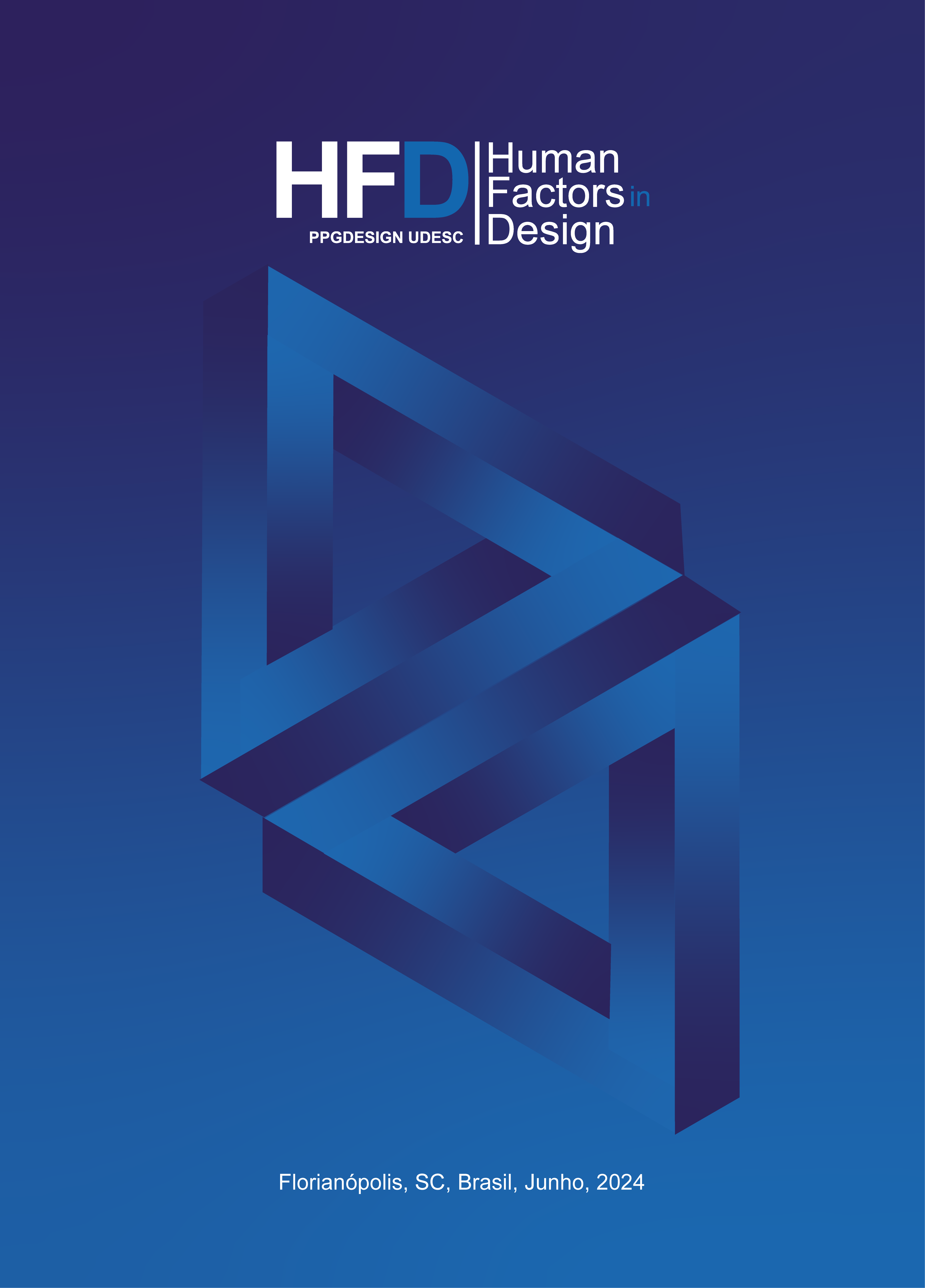Moda e inclusão: cocriação de vestuário para crianças e adolescentes com deficiência visual
DOI:
https://doi.org/10.5965/2316796313252024140Palavras-chave:
moda, inclusão, cocriação, deficiência visual, criançasResumo
Partindo da importância de estimular crianças e adolescentes com deficiência visual nas sensações táteis, auditivas, e para interações com o ambiente ao seu redor, este artigo objetivou: o contato com uma instituição que realiza estimulação visual/ essencial; aplicação do Co-wear: Método de Cocriação de moda funcional junto aos participantes, seus pais e professores; projeto, desenvolvimento e avaliação de uma coleção de moda funcional que atendesse os requisitos de projeto dos participantes. A partir de uma pesquisa aplicada, qualitativa, exploratória e da realização de estudos de casos os objetivos foram alcançados. Foram desenvolvidas 8 camisetas com recursos táteis, auditivos e que favorecessem as interações dos participantes, que experimentaram e avaliaram bem os vestuários.
Downloads
Referências
ALMEIDA, Iris Brenda Mendes Souza e Silva., LUCIAN Rafael, ABREU Nelsio Rodrigues. Sensorial Merchandising: um experimento no varejo de moda para inclusão de consumidores cegos. Revista de Empreendedorismo e Gestão de Micro e Pequenas Empresas, Portugal, v.8, n.1, p. 126-148, Jan/Abr. 2019.
BRAGA, Marcos. Design de Superfície. 2º edição. São Paulo: Blucher, 2018. 107 f.
BRASIL. Lei 8069 de 13 de julho de 1990. Estatuto da Criança e do Adolescente. 1990. Disponível em: https://www.planalto.gov.br/ccivil_03/leis/l8069.htm .Acesso em: 17 de out. de 2023.
BRASIL. Lei 3298 de 20 de dez. de 1999. Política Nacional para a Integração da Pessoa Portadora de Deficiência. 1999. Disponível em: https://www.planalto.gov.br/ccivil_03/decreto/d3298.htm . Acesso em: 17 de out. de 2023.
BRASIL. Lei 6949 de 25 de ago. de 2009. Convenção Internacional sobre os Direitos das Pessoas com Deficiência. 2009. Disponível em: https://www.planalto.gov.br/ccivil_03/_ato2007-2010/2009/decreto/d6949.htm . Acesso em: 17 de out. de 2023.
BRITO, Inaye; SATO, Julia. Moda e Inovação: Desenvolvimento de roupas para pessoas com deficiência. In: SECRETARIA DE ESTADO DOS DIREITOS DA PESSOA COM DEFICIÊNCIA. 9º Concurso Moda Inclusiva. São Paulo: Estação das Cores e Letras, 2017.
BONONI, Juliana et al. Aspectos inclusivos do design de moda para crianças com cegueira. In: 15º ERGODESIGN, 2015. Anais do 15º Ergodesign, Recife-PE, p.1-13.
BROGIN, Bruna. Método de Design para Cocriação de Moda Funcional para Pessoas com Deficiência. Curitiba, 2019. Tese (Doutorado) - Curso de Artes, Comunicação e Design, Universidade Federal do Paraná.
BROGIN, Bruna. A importância da moda inclusiva para pessoas com deficiência. In: NAÇÃO BRASIL. Um olhar diferente sobre a moda. Florianópolis: Nação Brasil, 2023, p. 35-49.
CARLETTO, Marcia Regina Vissoto. A estimulação essencial da criança cega. Paraná, [2009?].
CBO - CONSELHO BRASILEIRO DE OFTALMOLOGIA. As Condições de Saúde Ocular no Brasil. 2012. Disponível em: https://www.cbo.com.br/novo/medico/pdf/02-cegueira.pdf . Acesso em: 18 jan. 2022.
CBO - CONSELHO BRASILEIRO DE OFTALMOLOGIA. As Condições de Saúde Ocular no Brasil. 2019. Disponível em: https://www.cbo.com.br/novo/publicacoes/condicoes_saude_ocular_brasil2019.pdf . Acesso em: 18 jan. 2022.
CONSELHO DE DESIGN DA NORUEGA. Innovating with people: the business of inclusive design. Noruega: Norsk Designrad, 2010. 96 p.
COOK, Albert. M.; POLGAR, Jan Miller. Assistive Technologies: Principles and Practices. St. Louis, Missouri: Mosby - Year Book, Inc, 1995.
GIL, Antônio Carlos. Como elaborar projetos de pesquisa. São Paulo: Atlas, 1991.
GRIFIN, Harold. C; GERBER, Paul. J. Desenvolvimento tátil e suas implicações na educação de crianças cegas. Revista Benjamin Constant, nº. 5, 1996. Publicado em 2017. Disponível em: https://revista.ibc.gov.br/index.php/BC/article/view/658 .Acesso em: 18 out. 2023.
INSTITUTO BRASILEIRO DE GEOGRAFIA E ESTATÍSTICA (IBGE). Censo Demográfico 2010: Características gerais da população, religião e pessoas com deficiência. São Paulo: IBGE, 2010. 215 p.
NAÇÃO BRASIL. Um olhar diferente obre a moda. Florianópolis: Nação Brasil, 2023.
NOGUEIRA, M. L. L. A importância dos pais na educação segundo a percepção de universitários deficientes visuais. Revista IBC, ed. 23, dez. de 2002. Disponível em: http//www.ibc.gov.br/ . Acesso em: 29 ago. 2023.
Downloads
Publicado
Como Citar
Edição
Seção
Licença
Copyright (c) 2024 Human Factors in Design

Este trabalho está licenciado sob uma licença Creative Commons Attribution 4.0 International License.
Os artigos publicados pela revista são de uso gratuito, destinados a aplicações acadêmicas e não comerciais. Os direitos autorais são todos cedidos à revista. Os artigos cujos autores são identificados representam a expressão do ponto de vista de seus autores e não a posição oficial da revista Human Factors Design. O (s) autor (es) se compromete a sempre que publicar material referente ao artigo publicado na Revista Human Factors Design mencionar a referida publicação da seguinte forma:
Este artigo foi públicado originalmente pela Revista Human Factors Design em seu volume (colocar o volume), número (colocar o número) no ano de (colocar o ano) e pode ser acessado em: https://periodicos.udesc.br/index.php/hfd/index


